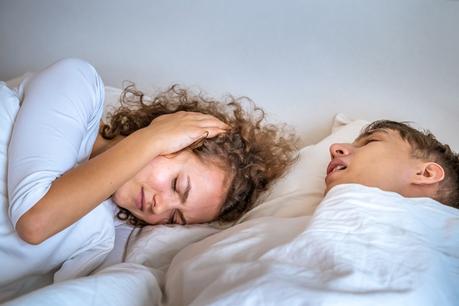What is obstructive sleep apnea? Many people have heard the term but are unsure of what it really is. Here we shall clarify this issue by explaining the obstructive sleep apnea symptoms, obstructive sleep apnea causes, what its effects are, how it is diagnosed, and how it is treated. However, let's first answer the question "what is obstructive sleep apnea?"
First, the term 'apnea' refers to a periodic loss of airflow. Not just a partial loss, but a complete stop to the flow of air. A partial stop to the flow of air into and out of your lungs is known as a hypopnea leading to abnormally slow or shallow breathing. This causes interruptions of sleep of the person who suffers from the condition. The tissues in the upper airway lose their tightness and relax, and long with the effect of gravity, tend to obstruct or even block the airway. Most of those affected by the condition start snoring as this process proceeds, and the tissues soft tissues at the back of your throat begin to vibrate.
The obstruction of your airway also reduces the level of oxygen in your lungs, leading to a reduced level of oxygen in your blood. Referred to as hypoxemia, this can lead to an increased heart rate to make up for the lack of oxygen, and reduced brain function, an abrupt short awakening from sleep while choking and gasping, and waking up with a sore throat and/or a dry mouth. A continual chronic oxygen deficiency, while you sleep, can lead to many other health issues, including cardiovascular disease, high blood pressure, stroke, and sometimes even depression and obesity. You may also wake up with a headache and find it difficult to concentrate during the day.
What is Obstructive Sleep Apnea?
Before we go any further, it is important to understand that there are three types of sleep apnea, namely:
Central sleep apnea (CSA): This is where the brain's control of muscles used in respiration (breathing) is faulty and breathing becomes shallower and slower.
Obstructive sleep apnea (OSA): Where breathing is physically restricted by an obstruction in the airway. Not generally by something getting stuck in your throat but by throat tissues obstructing or blocking the airway.
Complex sleep apnea: Also known as mixed sleep apnea, this is a combination of CSA and OSA. It was first noted by the Mayo Clinic and published in ScienceDaily in September 2006. It was recognized as a different type of apnea because when a continuous airway pressure (CPAP) machine was used, it did not completely resolve the problem. When the CPAP machine was used on complex sleep apnea patients, they still could not breathe properly even though the obstruction had apparently gone. There had to have been another type of sleep apnea in play.
OSA, as it is often referred to, can lead to several conditions from reduced or a lack of libido, to depression. In 2014, the Journal of Clinical Sleep Medicine published a study suggesting that OSA can be one cause of chronic traumatic encephalopathy (CTE) which is characterized by memory loss, depression, dementia, and potentially premature death. With this knowledge, let's first have a look at what obstructive sleep apnea actually is.
Obstructive Sleep Apnea Symptoms
There are several sleep apnea symptoms, a few of which have been briefly mentioned above. Here is a more comprehensive list of the more common symptoms of obstructive sleep apnea.
- Loud snoring: This is normally due to the soft tissue obstruction at the back of the throat.
- Stopped breathing: You may be unaware of this yourself, but others may notice you stop breathing during sleep for short periods.
- Suddenly awakening: Obstructive sleep apnea causes you to abruptly wake up for a short time and find yourself choking and gasping for air.
- Waking with a sore throat and/or a dry mouth: This can be caused by the continual vibration in your throat and to a lack of saliva. Saliva can also be dried up by breathing through your mouth.
- Headaches: You may wake up with a headache.
- Sleepiness during the day: you may feel very sleepy during the day, due largely to the poor quality of sleep that OSA leads to.
- Lack of concentration during the day: this is due to the same reason above for sleepiness.
- Mood changes during the day: Your mood may change during the course of the day. You may become more irritable or suffer from depression.
- Decreased sex drive: This is one of the obstructive sleep apnea symptoms that men would prefer to avoid. A lack of libido can be caused by excessive tiredness
- High Blood Pressure: High blood pressure can be a serious condition in many people. It can lead to strokes and cardiac arrest. If HBP is caused by obstructive sleep apnea, then it is important to control the OSA.
There are other symptoms of the condition, but the above are more than enough to indicate how serious obstructive sleep apnea can be. When you consider them together, the above list of sleep apnea symptoms can lead to a very unsatisfactory life for those that suffer from the condition. It is important to examine what causes OSA. There is no specific single cause, and we explain a few below.
Obstructive Sleep Apnea Causes
We have discussed obstructive sleep apnea symptoms above, and who may get it. However, what causes this condition? What are the main obstructive sleep apnea causes, and why do all these symptoms arise? The major causes are explained by the term given to the condition: obstructive sleep apnea. So what can cause the obstruction? There are many ways in which the airway can become obstructive, the more common of which are:
Physical obstructions to the airway: Your airway can be obstructed by an excess of fat around it, and by thickened tissue. As air gets compressed as it passes through an obstructed airway it can cause whistles, wheezes, and snoring. As explained above, those with larger neck diameters are more susceptible, as are pregnant women in their third trimester.
Relaxation of muscles: When people fall asleep, the muscles in the airway relax. Rather than keeping the airway open, they narrow it. Your tongue also relaxes, contributing to the blockage. This is a natural effect of sleep, and would not normally affect the airflow from the lungs to the mouth and outside. However, it can, and in obstructive sleep apnea, it does this! If your airway is complexly blocked, you stop breathing for up to 20 seconds. Once the brain notices this it sends a signal to the muscles and they tighten up again. This enables the airflow to begin again. It is this short breathing stoppage that is known as apnea. The sequence can happen hundreds of times each night without you being aware of it. Here are some other factors involved in OSA.
Obesity: Obesity is one of the main characteristics common to many people who suffer from OSA. In fact, it is suggested that it is a factor involved in 60% of OSA cases. Not only is obesity more prevalent among adults and adolescents with OSA, but it can also help promote the development of OSA. Obesity is a major reason for a narrowing of the airway. Research published in PubMed on the effect of obesity has indicated that an increase of 10% in one's weight can increase the risk of sleep-disordered breathing six-fold. This also applies to an obstructive sleep disorder, being the most common form of sleep-disordered breathing. The relationship between obstructive sleep apnea and excess body weight is complex because, not only can obesity lead to OSA, but it is also more prevalent among OSA patients. 58% of adult OSA cases are obese. So which causes what?
Insomnia: There appears to be a connection between insomnia and OSA. Those suffering from insomnia may be experiencing the first symptoms of obstructive sleep apnea.
Traumatic brain injury: A study of the prevalence and consequences of sleep disorders in subjects who had previously had a traumatic brain injury (TBI) indicated that such subjects were more likely than normal to suffer from obstructive sleep apnea as a consequence. In fact, 46% of such subjects suffered from sleep disorders in general and 23% of those who had TBI developed OSA.
Anatomical characteristics. The size and positioning of a person's neck, jaw, tongue, tonsils, and other tissue near the back of the throat can directly affect airflow.
Cigarette smoking: Studies have shown that smokers, particularly heavy smokers, are more likely to get OSA at a higher rate than people who don't smoke. However, stopping smoking can reduce the rate to zero. So quit smoking if you want to avoid obstructive sleep apnea - particularly if you are also overweight.
Excessive alcohol consumption: Alcohol consumption can induce obstructive sleep apnea. Not only that but if you already suffer from sleep apnea excess alcohol can make your condition worse. One reason for this is that alcohol relaxes you including the throat muscles, and its consumption can lead to a longer time period between you stopping breathing and starting breathing again. This can lead to an oxygen deficiency, known as desaturation, in the blood. This condition can be fatal! Alcohol also makes it more likely that the upper airway will collapse while you sleep leading to snoring and OSA. A heavy drinking session can also lead to episodes of obstructive sleep apnea in people who have never had it before.
Sleeping position: Sleeping on your front or side is OK, but if you sleep on your back the tissues around your airway can collapse, leading to blockages in your airway. If you are susceptible to OSA then sleep on your stomach or your side.
Who Gets Obstructive Sleep Apnea?
In the USA, around 40 million men, women, and children get obstructive sleep apnea, although men are the most susceptible. Almost 20% of American males and 9% of women have had OSA at some time in their lives. 11% of children born at term have experienced it. However, it is 3 to 6 times more common in children born pre-term. There is more to it than just gender or whether or not a child was born at term. Men with a neck circumference greater than 17 inches and women over 15 inches are more likely to get obstructive sleep apnea than those with thinner necks.
Men in their middle age are 2-3 times more likely to develop this condition than women. Most cases are aged between 40 and 60 years of age. Before and after these ages case numbers tend to be less. Their greater neck circumference and longer pharyngeal airway enable OSA more likely to develop. Almost 80% of pregnant women show some symptoms of obstructive sleep apnea, though these usually appear during the third trimester. Smoking is another issue: smoking inflames the upper airway and also leads to fluid retention. This makes developing OSA 3% more likely.
Obstructive Sleep Apnea Risk Factors

In addition to the above causes of obstructive sleep apnea (causes of OSA), some factors indicate a higher risk of individuals developing the condition. Among the most common of these are:
Chronic sinusitis: People with sinusitis (and also nasal congestion) also tend to suffer from swelling and inflammation of the upper airway. This can put them at risk of obstructive sleep apnea.
Recent weight gain: Those who have recently put on more weight than they should sometimes find that they also contract OSA. Check 'Obesity' in 'obstructive sleep apnea causes' above.
Diabetes: According to the CHEST Journal, Individuals with Type 2 diabetes are often co-diagnosed with OSA, where Type 2 diabetes prevalence rates range between 15% to 30% within the OSA population. The way that OSA and Type 2 diabetes are related maybe because the fragmented sleep and irregular hypoxemia (reduced levels of oxygen in the blood) caused by OSA may lead to irregular blood glucose metabolism. However, it is also possible that the relationship between OSA and Type 2 diabetes is bidirectional. This is because diabetes-related nerve dysfunction may affect the respiratory system and lead to breathing issues during sleep.

Down Syndrome: According to the National Down Syndrome Society (NDSS), anatomy is primarily responsible for obstructive sleep apnea in those with Down syndrome. In a test carried out in 2002 by a team in Madrid, Spain, on 108 Down syndrome children aged 1 - 18, it was found that 64.7% of boys exhibited symptoms of sleep-disordered breathing. The figure for girls was 38.5% with an overall prevalence of 54.6% irrespective of gender. The main cause of obstructive sleep apnea in such patients was an increase in the tonsil tissue. This significantly enlarges the tonsils which in turn constricts breathing. Obesity, adenoid swelling, and congenital heart disease did not appear to contribute to the obstruction during this test, although in some cases it may.
Menopause: In January 2019, Medscape published a study by Gila Hertz, PhD, ABSM on sleep dysfunction in women. Part of this study noted that postmenopausal women are twice as likely to develop obstructive sleep apnea than those that had not yet gone through menopause. It was also noted that OSA occurred mainly during REM (rapid eye movement) sleep. They were also prone to other sleep-related disorders such as restless leg syndrome and periodic limb movement disorder (PLMD).
Family History: If obstructive sleep apnea is fairly common in your family, then it is likely that you will also suffer it unless you take steps to avoid the causes of your family members' OSA.
Treatment for Sleep Apnea
Treatment for obstructive sleep apnea is generally restricted to lifestyle changes. These changes are designed to overcome or reverse the obstructive sleep apnea causes and risk factors listed above. Here are the most common changes to make, most of which are easy to carry out.
Change sleep position: Stop sleeping on your back if that is your normal sleeping position. Turn onto your side (left or right makes no difference) or onto your stomach. Any sleeping position other than your back will make an improvement and may even prevent you from developing OSA.
Lose weight: If you feel you are overweight then even a moderate weight loss should make a difference and provide relief from sleep apnea. If you continue losing weight, you may even cure your sleep disorder, particularly if it is the main cause of your condition.
Keep your nasal passages clear: Clearing your nasal passages with a saline nasal spray or a neti pot clears them so that they do not present an obstruction to your breathing. Note: A neti pot is a small pot that can be used to pour water into your nostrils and clear them of mucus.
Avoid alcohol and tranquilizing medications: As explained earlier, alcohol can relax the muscles in your throat enabling them to collapse when you sleep and cause a blockage - leading inevitably to obstructive sleep apnea. Eliminate alcohol, and your condition will get better or even cured. Sleeping pills and tranquilizers can also be the cause, and eliminating them will cure your OSA if they are responsible.
Continuous positive air pressure (CPAP) therapy: A CPAP machine blows air into your mouth and/or nose at a pressure that forces your throat to open up and relieves the obstruction to your breathing. A CPAP machine can keep your throat open while you sleep, thus preventing apnea.
OSA in Women
Irrespective of age, OSA is less severe in women than in men. It is known that postmenstrual women are twice as likely to develop obstructive sleep apnea than premenstrual women, but overall they are less likely to develop severe OSA than men. Menstruation produces a hormone (progesterone) that can reduce the likelihood of OSA developing. More on this below.
Studies have shown that resistance to the opening of the upper airway is greater in the follicular phase of menstruation (start of the period to ovulation) and least in the luteal phase (ovulation to start of next period.) During the luteal phase, the sac that contained the egg produces estrogen and progesterone. It is believed that progesterone reduces the likelihood of airway blockage due to its effect on the dilator muscle of the pharynx, making OSA less severe in women than in men. An American Thoracic Society publication clearly explains the part played by the pharynx in obstructive sleep apnea.
Obstructive Sleep Apnea in Pets
Obstructive sleep apnea in pets, particularly in cats and dogs, can be very serious. You may become aware of OSA in dogs if you hear them snoring. Dogs and cats can snore like humans, but if your pet is gasping or choking at the same time get them to a vet immediately. It is so serious in animals that several cases have been reported of young cats or dogs dying suddenly in their sleep.
OSA in Dogs: Sleep apnea in dogs is not uncommon, and they experience the condition in much the same way as humans do: a temporary stoppage of breathing followed by a jolt that awakens them to start breathing again. The dogs most at risk are those with allergies (e.g. English bulldogs) and short noses, e.g. rottweilers, mastiffs, bulldogs, and pugs. If this happens regularly, then your dog will become sleep-deprived and hence irritable, and also to a number of both short-term and long-term health risks. Unfortunately, CPAP machines are not available for dogs yet, but a diet to reduce their weight, pharmaceuticals, or even surgery to reconstruct excessively small or malformed nostrils and airways may be recommended by your veterinarian.
OSA in Cats: Obstructive sleep apnea symptoms can be similar in cats as in dogs. Cats can snore the same as dogs can, but you should pay particular attention to its snoring and seek the advice of a veterinarian. The most common treatment for cats is surgery. However, CPAP can now be used on cats to help them breathe properly. Not yet available for dogs. If left untreated, however, your cat will likely not survive over the longer term.
Obstructive Sleep Apnea (OSA) Questions and Answers

Obstructive Sleep Apnea: Conclusion
So what is obstructive sleep apnea (OSA)? It involves a periodic complete cessation of airflow into your lungs. There are no medicines or drugs that can prevent this, only a change in your lifestyle. While not fatal in itself, OSA can exacerbate the effects of other conditions and lead to very serious conditions such as a stroke, cardiac arrest, or even sudden death. Can it be cured? Perhaps it may go away, but not without specialized treatment or significant changes to your lifestyle. Losing weight is one way of reducing the risk of getting it, or of reducing its effects if you have it. Surgery is another way, as suggested above, but the main way is to lose weight and exercise frequently.

